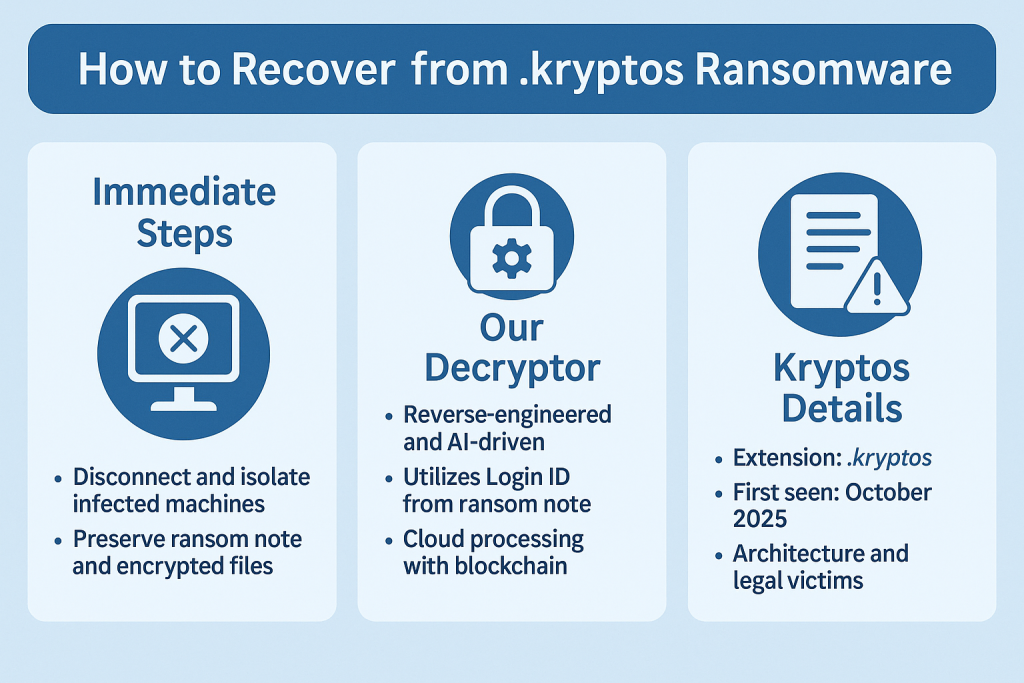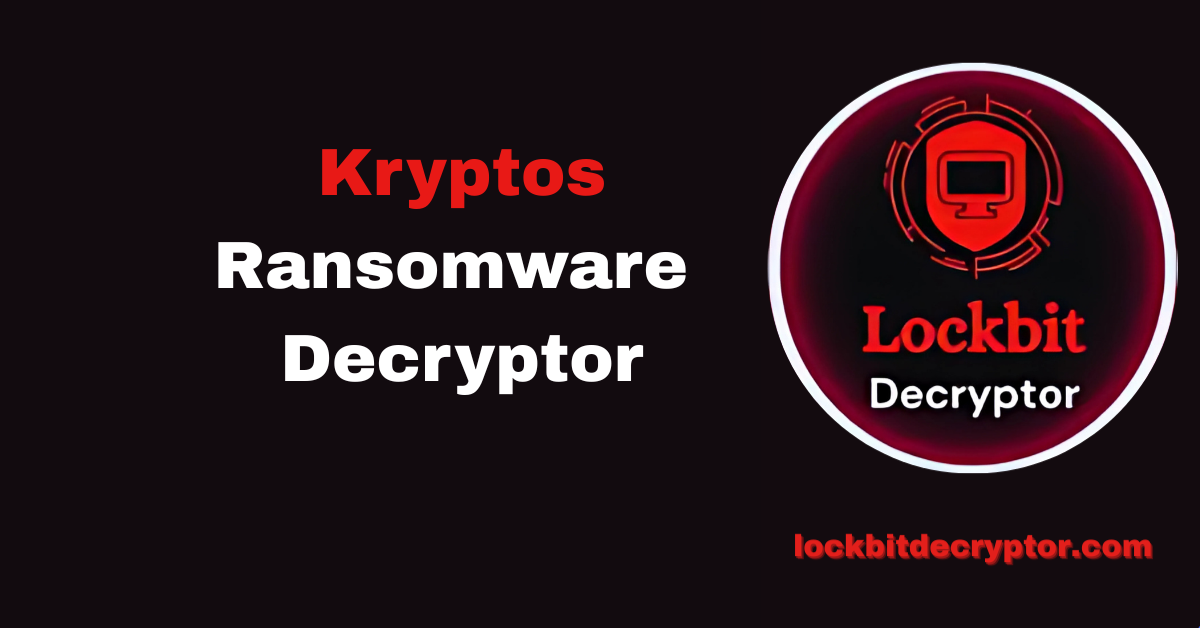How to remove Kryptos Ransomware and Decrypt .kryptos Files?
Our Kryptos Decryptor: Rapid Recovery, Expert-Engineered
We provide an enterprise-grade incident and recovery offering tailored for Kryptos incidents. Our approach combines forensic analysis, safe sample handling, and proven recovery techniques to maximize the chance of full restoration while minimizing further harm to your environment. We do not run untrusted third-party tools on production systems — we analyze samples in isolated labs and validate any decryption approach before application.
Related article: How to Decrypt .bSobOtA1D / .babyk Ransomware and Recover Files?
How It Works?
- Controlled Forensic Intake: We ingest ransom note(s), encrypted-file samples, and full telemetry into an isolated lab environment for static and dynamic analysis.
- Key & Variant Analysis: We reverse-engineer encryption mechanics and search for implementation weaknesses (seed reuse, weak key derivation, timestamp seeds, etc.).
- Validation & Test Decrypt: Any decryption routine is first validated on copies of sample files in a read-only sandbox to prove integrity before any production recovery.
- Cloud-Assisted Orchestration (optional): For large datasets we can securely orchestrate offline/air-gapped processing or vetted cloud processing with cryptographic integrity proofs and audit logs.
- Restore & Harden: After recovery, we assist with remediation: patching, credential rotation, segmentation and backup hardening.
Also read: How to Decrypt FIND Ransomware (.FIND) Files Safely?
Requirements
To engage in a Kryptos recovery evaluation we need:
- A copy of the ransom note (file or screenshot).
- Several encrypted file samples (preferably with original filenames).
- EDR/Sysmon logs and process timelines from infected hosts.
- Network logs (firewall/proxy) and any exfiltration evidence.
- Access to backups and snapshots for restore planning.
- Administrative personnel for validated restores and credential rotation.
Immediate Steps to Take After a Kryptos Incident
- Disconnect & Isolate: Immediately isolate affected hosts and segmented networks to prevent lateral spread.
- Preserve Everything: Make read-only copies of encrypted files and the ransom note(s). Do not alter encrypted files.
- Capture Volatile Data: If feasible, capture memory images and live process lists before reboot.
- Collect Logs & Snapshots: Gather EDR, Sysmon, firewall/proxy logs, and backup manifests.
- Engage Response Experts: Contact your IR team, legal counsel, and insurer. If using external help, only engage vetted response vendors.
- Avoid Unknown Decryptors: Do not run publicly posted or unverified decryptors on production systems — they can be destructive or side-channel exfiltration tools.
Also read: How to Decrypt XxzeGRBSr (.XxzeGRBSr) Ransomware Files?
How to Decrypt Kryptos and Recover Your Data
Free Methods
- Vendor Decryptors: Monitor established sources (AV vendors, No More Ransom, trusted labs). As of the latest tracker snapshot Kryptos technical artifacts were not yet widely published — watch for vendor advisories.
Backup Restore
- Preferred path: Restore from verified offline or immutable backups. Validate integrity using checksums and mount tests before wide-scale restoration.
VM Snapshots
- Fast rollback: If clean snapshots exist, revert carefully. Ensure snapshots were not deleted or tampered with by attackers.
Researcher Brute-Force / Crypto Flaw Exploits
- Conditional option: If analysis reveals weak key derivation or timestamp-based seeding, targeted brute-force or GPU-accelerated approaches may succeed. This requires substantial compute and careful validation.
Paid Methods / Paying Ransom
- High risk: Payment does not guarantee full recovery or non-recurrence. Consult legal and insurance teams and insist on a test file decryption prior to any payment.
Third-Party Negotiators
- Use only experienced negotiators who can validate decryptor functionality before payments are made and who adhere to legal, ethical, and evidentiary best practices.
Our Specialized Kryptos Response Offering
- Variant triage & lab analysis: We collect and analyze samples in isolated labs, develop YARA rules and detection signatures, and produce threat intelligence packages.
- Proof-of-Decryption testing: We validate any decryptor on copies of your encrypted files in an air-gapped environment and provide audit logs.
- Full remediation & recovery orchestration: From credential resets and network hardening to backup validation and phased restore plans.
- Post-incident review: Root-cause analysis, controls improvement, and tabletop/lessons-learned sessions.
Offline vs Online Decryption Methods
- Offline (Air-gapped) Analysis: Preferred for unknown families — prevents accidental data exfiltration and ensures controlled testing.
- Online Cloud-Assisted: Used for scale only with strict cryptographic integrity checks, vendor attestations, and encrypted transport.

What is Kryptos (.kryptos)
Kryptos appeared on public ransomware monitoring feeds on 2025-10-08 with a Tor leak-site hostname and three victims recorded on the tracker. The leak-site signal indicates an operator practicing double-extortion (data theft and public leak) is likely — treat this as an extortion risk requiring fast containment, evidence gathering and sharing with law enforcement and trusted intel partners.
Tools, TTPs & MITRE Mappings
- Initial access: compromised VPN/RDP credentials, public-facing appliance exploits. Map to MITRE T1078 / T1210.
- Credential theft: Mimikatz, LaZagne or equivalent credential-dumping tools (T1003).
- Lateral movement: PsExec, WMI, SMB-based lateral tools (T1021).
- Data exfiltration: Rclone, WinSCP, Mega, FTP or cloud storage (T1567 / T1048).
- Encryption/cleanup: mass file modification, shadow copy deletion (vssadmin), and scheduled task creation (T1486/T1490).
- Persistence: service creation, scheduled tasks, and backdoor installation.
Map alerts and telemetry to these TTPs for prioritized hunting.
Known Indicators of Compromise (IOCs)
- Tracker signal: leak-site Tor hostname and three victim entries observed on ransomware monitoring feeds (2025-10-08). Use the leak-site URL in dark-web monitoring watchlists.
- Hashes/domains/extension: At the time of the initial tracker snapshot, public technical IoCs were sparse. If you locate encrypted files (e.g., .kryptos) or a ransom note, immediately extract file hashes (MD5/SHA1/SHA256), sample strings, and any network indicators and circulate via vendor portals and ISACs.
Mitigations and Best Practices
- Harden remote access: require MFA, use VPN conditional access and IP allow lists for management services.
- Patch external appliances: prioritize VPN/firerouter/ASA/FortiGate vulnerabilities and apply vendor patches
- Backup strategy: implement immutable, offline backups and test restores regularly.
- EDR & logging: deploy and tune EDR and Sysmon; alert on credential-dumping behavior and large-scale file renames.
- Network segmentation & least privilege: limit lateral movement and privileged account exposure.
- Incident readiness: maintain an IR playbook, contact lists for vendors and law enforcement, and evidence preservation procedures.
Ransom Note — What to Extract
- Full note text and screenshots.
- Any login ID, TOR chat link, or code.
- Wallet addresses and any payment instructions.
- Sample file names and the extension appended (e.g., .kryptos) and full file hashes.
- Time stamps of when files were modified and when the note appeared.
Conclusion and Next Steps
Kryptos ransomware(.kryptos) is a live extortion signal observed on major trackers — treat the presence of a leak site as confirmation of the operator’s intent to extort via data publishing. Prioritize rapid isolation, evidence collection, and responsible sharing of any samples. If you have a ransom note, encrypted files, or telemetry from an incident, provide them now and we will:
- Extract IoCs and produce YARA signatures;
- Map TTPs to MITRE ATT&CK and provide SIEM/EDR detection queries;
- Validate any candidate decryptors in a safe lab and orchestrate recovery.
Frequently Asked Questions
Contact Us To Purchase The Kryptos Decryptor Tool






